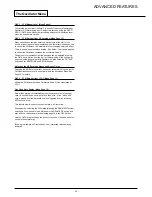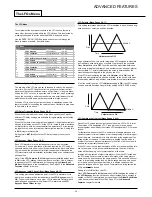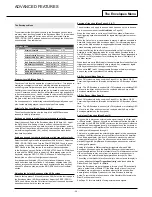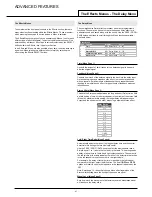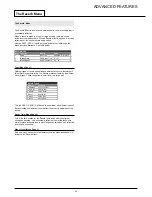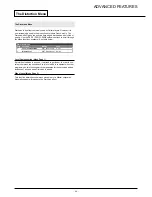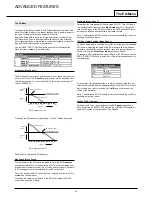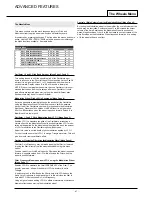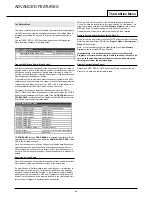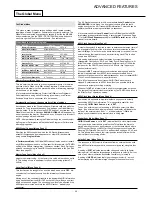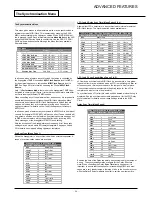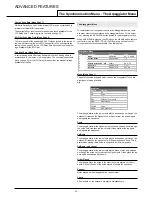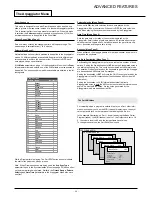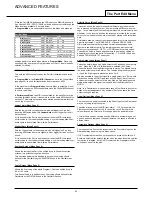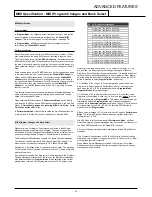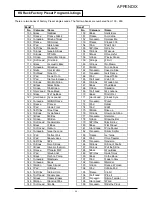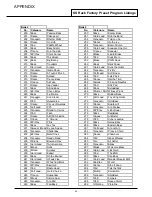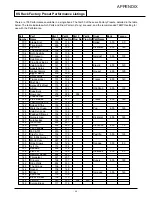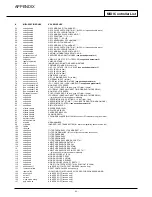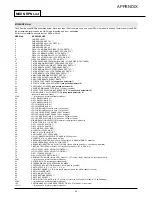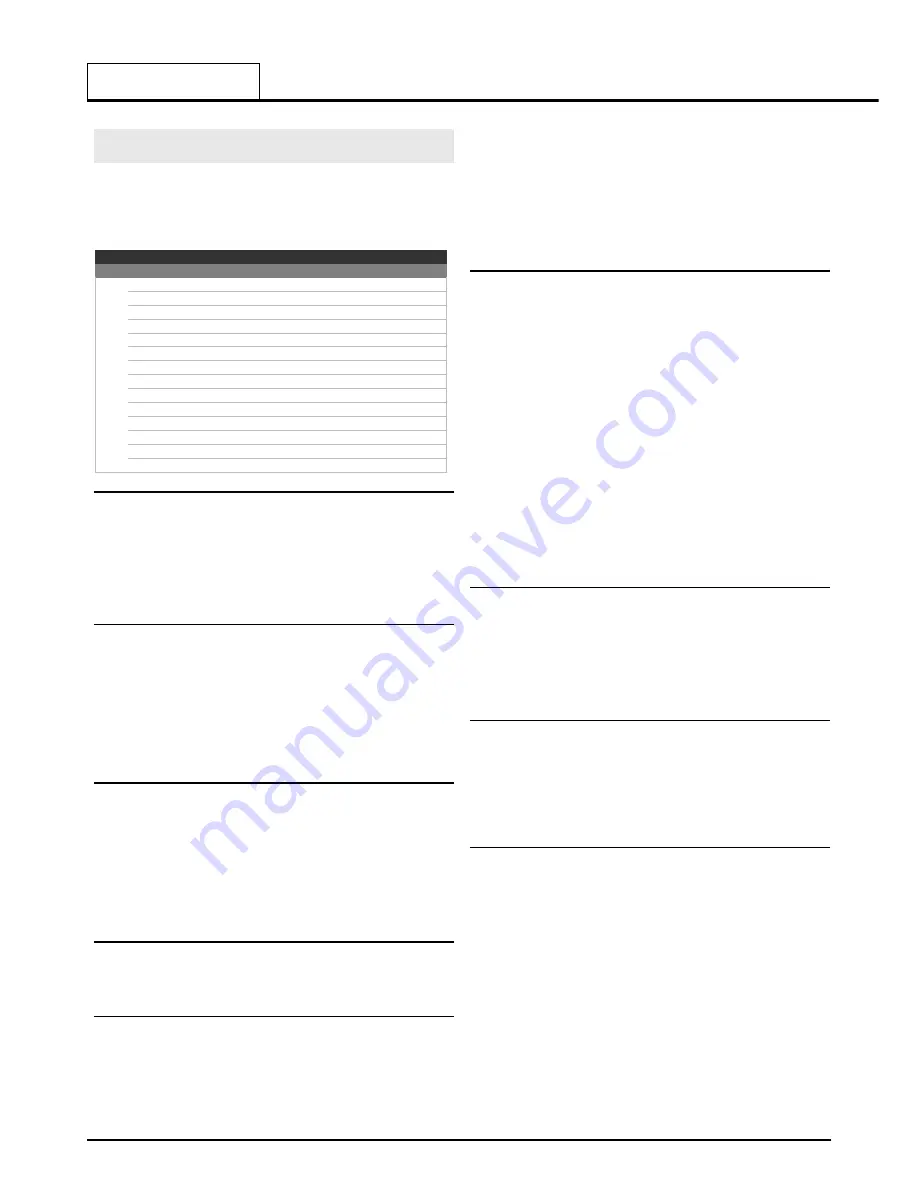
ADVANCED FEATURES
The Global Menu
•
50
•
The Global Menu
This menu is used to change various settings which remain constant
regardless of which Program or Performance is currently selected. The
Global Menu is selected by pressing the keypad ‘
0
’ button the MENUS
button is selected. Use the PERF / PROG / PAGE up/down buttons to
scroll through the Menu functions available - See table below.
Memory Protect (Menu Page 1)
This is a safety switch, used to prevent accidental erasure of memories
and loss of data. When set to
ON
, writing Programs, Performances or
Global data into memory will be prevented, and a brief warning message
will be shown on the display.
It is recommended that Memory Protect is left
ON
unless Programs /
Performances are being edited for storing into memory, or a System
Exclusive dump from a sequencer is to be received.
Permanently saving any changes made to Global settings
Any changes made to the Global settings will remain valid only while the
power is on. To permanently save any new settings, the Global Memory
must be saved. To do this, press the WRITE button at any time that the
Global Menu is active. A message
SAVING GLOBALS
will be appear for
a short period on the display. Once saved, even if the power is turned off,
any new settings will be memorised.
NOTE: After permanently saving the Global settings, the currently select-
ed Program or Performance will be the default Program or Performance
after applying power.
MIDI Global Channel (Menu Page 2)
Specifies the MIDI channel on which the KS Rack will transmit and
accept MIDI messages from a sequencer or other MIDI device while
being used in
Program Mode
.
In
Performance Mode
, the Global MIDI channel is also used to transmit
any MIDI messages which are not Part-specific (for example, the TEMPO
setting in the Effects / Arpeggiator / Hypersync section). Each Part trans-
mits and receives using its own MIDI channel as defined in the Part Edit
Menu (see page 55).
Master Tune Cents (Menu Page 3)
Adjusts the master tuning. At the factory, this value will have been set to
0
. This setting of zero is equivalent to concert pitch tuning (middle C =
440 Hz).
Local Control (Menu Page 4)
This function can be thought of as a switch which when set to
OFF
, dis-
connects the front panel controls from the internal synthesizer sound
engine.
Moving any of the controls still results in the appropraite MIDI information
being transmitted from the MIDI OUT socket, but they will have no direct
affect on the sound engine.
The sound engine will only be affected if the
MIDI signals are routed back into the MIDI IN socket - probably by a
sequencer.
The KS Rack also supports a third, non-standard
Local Control
option -
SEQUENCER
. In this mode, the front panel controls affect the synth
engine directly but do NOT transmit MIDI information. This mode can be
useful when Parts are being controlled by a sequencer.
It is recommended that
Local Control
is set to
ON
unless the full MIDI
implications are appreciated of having it set otherwise. Please see Page
17 in the
MIDI and Sequencers
chapter the
MIDI Tutorial
section of this
manual for more details.
MIDI Clock Source (Menu Page 5)
A master timing clock is required in order to determine the tempo (rate) of
the arpeggiator and to provide a time base for synchronization to other
musical timings. This clock may be derived internally or received from an
external device that is able to send a master timing clock (This is often
known as a MIDI clock).
This setting determines whether the tempo synchronised features
(Arpeggiator, Chorus Sync, EQ Sync, Delay Sync & Panning Sync) will
follow the tempo of an external sequencer (external clock) or follow the
tempo set by the TEMPO knob found in the Effects / Arp / Hypersync
section (external clock).
When set to
EXT
, external clock synchronisation is being used and the
temp will be calculated from MIDI Clock messages received from a
sequencer. Make sure sure the external sequencer is set to transmit MIDI
Clock. Consult the sequencer manual for details.
Note : Most sequencers do not transmit MIDI Clock while they are
stopped. Synchronization to MIDI Clock will only be possible while the
sequencer is actually recording or playing.
When set to
INT
, an internal clock is used for synchronisation purposes.
The tempo of the internal clock is controlled by the TEMPO knob found in
the Effects / Arp / Hypersync section.
MIDI Clock Input Status (Menu Page 6)
Sometimes it is desirable to monitor whether a sequencer is actually
transmitting MIDI Clock information. This is especially useful for trou-
bleshooting if
MIDI Clock Source
is set to
EXT
.
To see if an external device is sending a MIDI clock, select this Menu
Page. If an external clock is being received, the display will indicate the
tempo of the external clock. If not
- -
will be displayed. If
ON
is dis-
played, synchronisation to the internal clock is being used.
Global Sync Mode (Menu Page 7)
If
MIDI Clock Source
is set to
EXT
(external clock), a clock synchroniza-
tion type may be selected using this function This allows the
first note
played after all notes have been released
or
the first note played after a
MIDI Program Change or MIDI Start Song Message
to synchronize the
Panning, EQ Filter and Chorus LFOs as described on pages 43, 45, and
46. This allows them to have their start position locked in time with the
musical piece for stunning effects.
Velocity Curve (Menu Page 8)
The response to MIDI velocity information from an external device such
as a MIDI controller keyboard or a sequencer may be set using this func-
tion.
A setting of
SOFT
indicates that smaller changes in velocity (a lighter
playing style) will create a large change in response to velocity, be it vol-
ume or any other modulation destination that velocity is routed to.
A setting of
HARD
indicates that higher changes in velocity - a much
harder playing style, will create large changes in response to velocity.
Global Menu (not stored in programs)
Page Function
Display
Value
1
Memory Protection
Memory Protect
OFF-ON
2
Global MIDI Channel
Global Midi Channel 1…16
3
Master Tune Cents
Master Tune
-64…63
4
Local Control
Local Control
OFF…SEQ
5
Midi Clock Source
Clock Source
INT-EXT
6
Midi Clock Input Status
Ext Clock Status
-- / ON / bpm value
7
Global Sync Mode
Global Sync
NOTE 1…SNG ST
8
Velocity Curve
Velocity Curve
SOFT-HARD
9
Function Display Time*
Display Time
0…127
10
Prog Mode Display Control*
Display Control
TIME-PERM
11
New Menu Always Page 1
New Menu Page
OFF-ON
12
Input Sensitivity Range
Input Sens
LIN-MIC
13
Input Trim dB
Input Trim
-10…20
14
Input Trigger Sensitivity
In Trig Sens
0…127

